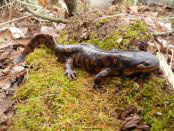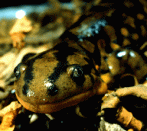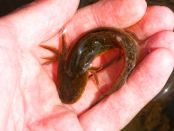Ambystoma tigrinum (Green, 1825)



Key Characters: Large head; dark body marked with irregular yellow spots or blotches, some extending onto belly.
Similar Species: Spotted Salamander. See Key to Adult and Larval Salamanders of Illinois for help with identification.
Subspecies: At least seven subspecies were recognized at one time, but most of those have been elevated to full species or are no longer recognized. The Eastern tiger salamander, A. t. tigrinum is found in Illinois.
Description: The largest terrestrial salamander in Illinois (up to 33 cm TL). Pattern varies from dark background and small yellow spots (juvenile) to large fused spots and blotches obscuring background (old adult). Hatchling larva lacks balancers and is yellow to tan with paired black blotches on back. Older larva has wide head, pale underside, and toes with broad, flat bases; occasional overwintering larva reaches adult size.
Habitat: Forests, woodlands, pastures, orchards, prairies, and cultivated fields. Tolerant of habitat disturbance within towns and cities, as long as breeding ponds remain.
Natural History: Adults live in burrows and under logs, rocks, and other cover and move about the surface at night especially after rain and during winter and spring breeding migration. Fish-free ponds are required for breeding and larval life. During February-April, females attach eggs to twigs, leaves, and plant stems under water in jelly-covered clusters of 20-50. Larvae grow fast and are important pond predators. Larvae transform in late summer or autumn. Adults feed on beetles, centipedes, slugs, worms, and other invertebrates.
Status: Persists but is not abundant where disturbed by agriculture and urban development. Imported larvae often sold as fish bait under the erroneous name “waterdogs.” Locally common.
Etymology: Ambystoma – amblys (Greek) for blunt; -stoma (Greek) meaning mouth; or anabystoma (New Latin) meaning ‘to cram into the mouth’; tigrinum – tigris and tigrinus (Latin) for ‘of tigers’.
Original Description: Green, J. 1825. Description of a new species of salamander. Journal of the Academy of Natural Sciences Philadelphia. 5 (Part 1):116-118.
Type Specimen: Not known to exist, collector unknown.
Type Locality: “Near Moore’s town in New Jersey” = Burlington Co., NJ, USA
Original Name: Salamandra tigrina Green, 1825
Nomenclatural History: The tiger salamander has one of the most complicated nomenclatural histories of any amphibian, with at least a dozen junior synonyms and more than 50 combinations. The most recent changes involve elevation of subspecies to species.


